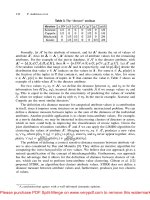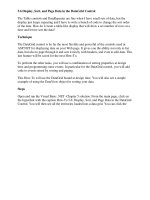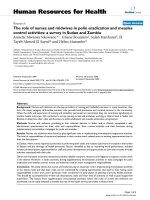ADVANCES IN MOTOR TORQUE CONTROL pdf
Bạn đang xem bản rút gọn của tài liệu. Xem và tải ngay bản đầy đủ của tài liệu tại đây (9.2 MB, 122 trang )
ADVANCES IN MOTOR
TORQUE CONTROL
Edited by Mukhtar Ahmad
Advances in Motor Torque Control
Edited by Mukhtar Ahmad
Published by InTech
Janeza Trdine 9, 51000 Rijeka, Croatia
Copyright © 2011 InTech
All chapters are Open Access articles distributed under the Creative Commons
Non Commercial Share Alike Attribution 3.0 license, which permits to copy,
distribute, transmit, and adapt the work in any medium, so long as the original
work is properly cited. After this work has been published by InTech, authors
have the right to republish it, in whole or part, in any publication of which they
are the author, and to make other personal use of the work. Any republication,
referencing or personal use of the work must explicitly identify the original source.
Statements and opinions expressed in the chapters are these of the individual contributors
and not necessarily those of the editors or publisher. No responsibility is accepted
for the accuracy of information contained in the published articles. The publisher
assumes no responsibility for any damage or injury to persons or property arising out
of the use of any materials, instructions, methods or ideas contained in the book.
Publishing Process Manager Masa Vidovic
Technical Editor Teodora Smiljanic
Cover Designer Jan Hyrat
Image Copyright oksana2010, 2011. Used under license from Shutterstock.com
First published September, 2011
Printed in Croatia
A free online edition of this book is available at www.intechopen.com
Additional hard copies can be obtained from
Advances in Motor Torque Control, Edited by Mukhtar Ahmad
p. cm.
ISBN 978-953-307-686-7
free online editions of InTech
Books and Journals can be found at
www.intechopen.com
Contents
Preface VII
Part 1 Torque Control in Motors Used in Dentistry 1
Chapter 1 Intelligent Torque Control Motors in Dentistry 3
Mohammad Hassan Zarrabi and Maryam Javidi
Part 2 Human Factor and Reactive Torque Control 11
Chapter 2 Experimental Verification of Reaction Torque Control
Based on Driver Sensitivity to Active Front Steering 13
Ryo Minaki and Yoichi Hori
Part 3 Effect on Efficiency of Motor with Torque Control 31
Chapter 3 Study on the Energy Efficiency of
Soft Starting of an Induction Motor with Torque Control 33
José de Oliveira, Ademir Nied, Mário Henrique Farias Santos
and Rogério Pinho Dias
Part 4 Sensorless Torque Control 47
Chapter 4 Sensorless Torque/Force Control 49
Islam S. M. Khalil and Asif Sabanovic
Part 5 Direct Torque Control 69
Chapter 5 Speed Estimation Using Extended Filter Kalman
for the Direct Torque Controlled
Permanent Magnet Synchronous Motor (PMSM) 71
M. S. Merzoug and H. Benalla
Part 6 Switched Reluctance Motor Torque Control 85
Chapter 6 Advanced Torque Control Scheme for the High Speed
Switched Reluctance Motor 87
Dong-Hee Lee, So-Yeon Ahn and Jin-Woo Ahn
Preface
More than fifty percent of total electrical energy generated is converted into
mechanical energy with the help of electric motors. If the efficiency of these motors is
improved, a large amount of energy can be saved. With the advent of power
electronics it is now possible to control the torque and speed of electric motors
precisely as needed, resulting in saving of energy.
In this book various methods of control of electric motors are discussed. Sensorless
control of motors requires the estimation of speed without actually measuring it.
Similarly now the torque is controlled directly by the direct torque control method
described in the book. Reluctance motors are also finding applications in many
industries like consumer appliances, automobiles and defense. Special application of
motors in dentistry is also described. The effect of human reaction on motor
performance is also described.
Dr. Mukhtar Ahmad,
senior member IEEE Professor,
Department of Electrical Engineering,
Aligarh Muslim University,
India
1
Intelligent Torque Control Motors in Dentistry
Mohammad Hassan Zarrabi and Maryam Javidi
Endodontic Department, Dental School,
University of Medical Sciences, Mashhad,
Iran
1. Introduction
Perhaps no instrument has more optimized in dentistry and the dentist over the past
century in the mind of the public than the dental headpiece. Prior to 1870 dentists had no
driven rotary tools. During the 1850-1870 periods various other instruments were advised to
rotate burs in cavities.
Early example of clock wise drill was patented in 1864, come into use by 1871, It was with
the advent of the foot engine that the first dental hand pieces came into being.
Straight hand pieces with a variety of intricate chuck-closing mechanisms became well
developed during the 1880, and since they were permanently linked to the foot – engine
flexible cable were converted into angle hand pieces by connecting so – called " lock – bit
attachments" to their front ends, these lock-bits being available in right angle, acute angle
and obtuse angle patterns.(Fig 1)
Fig. 1. Dental hand piece in 19
th
century.
From 1875 onwards, the use of the foot engine became widespread, but its demise was
foreshadowed by the advent of electric headpiece driving mechanism.
Early electric motors were designed to be attached to foot engines or alternatively as
independent entities.
In briefly, dental hand pieces are small, very specialized air as electric driven turbines used
in both high and low speed dental hand pieces.
Advances in Motor Torque Control
4
2. Structure of dental hand piece; turbine
A turbine is typically made up of multiple components including:
Rotor: Integral shaft on which components are mounted
Chuck: usually housed within the rotor.
Impeller: Component which converts energy from pressurized air or electricity in to the
rotational motion of the turbine required for cutting.
Bearing: Allow entire assembly to spin freely with as little friction as possible.
Rings: Provide firm seating inside hand piece head while minimizing vibration.
High speed dental hand pieces turn at approximately 400/000 revolutions per minute (rpm).
Slow speed dental hand piece turn at 150 rpm to 2000 rpm.(Fig 2)
Fig. 2. Structure of dental hand piece.
Because of the specialized nature, very high speed, the turbines that drive them must be
manufactured to the highest standards. Standard materials would result in imminent
failure, and possible harm to the patient on which the equipment was being used.
Hand piece manufacturers sometimes design hand pieces around the mast efficient, highest
power producing dental hand piece turbine that current technology allows.
Speed and torque is king where dental hand pieces are concerned and competition is fierce
between manufacturers.
3. What is torque?
Torque is a measure of how much force acting on an object cause that object to rotate.
Torque also called moment ox moment of force is a tendency of force to rotate an object on
axis, fulcrum, or pivot, just as a force is a push or a pull, a torque can be thought of as a twist.
In simple terms, torque is a measure of the turning force on an object such as a bolt oz a fly
wheel, for example, pushing oz pulling the handle of a wrench connected to a nut or bolt
produces a torque (turning force) that loosens or tightens the nut or bolt. (Fig 3)
Fig. 3. Turning force.
Intelligent Torque Control Motors in Dentistry
5
4. Torque in dentistry; root canal therapy
In many aspect of practice in dentistry, especially in root canal therapy for root canal
preparation, there is a turning force on an instrument.
Torque is a parameter that must be controllable in root canal preparation, because of
different instruments which have been used, seem to need different values of torque.
In root canal preparation, safety usage of instrument depends on considering the torque at
failure of instrument.
The instruments are subjected to different of torsional torque, if the level of torque is equal
to or greater than the torque at failure (fracture), the instrument will separate.
5. Torque control hand pieces
Different types of hand pieces are used in conjunction with the rotary instruments, the air
and electric motors without torque control and the electric torque control motors. (Fig 4)
Fig. 4. Torque control motor.
Theoretically, the torque control hand pieces (motors) take into consideration the torque at
failure of rotary instrument.
Torque values lower than the torque at fracture of the instruments can be set on the torque
control hand pieces.
When a high torque control hand pieces is used the instrument is very active and the
incidence of instrument locking and, consequently, deformations and separation would tend
to increase.
Air driven hand pieces or air motors do not allow torque control and variation in air
pressure could affect the rotational speed and, consequently, torque. For instance a drop in
air pressure would lead to a decrease of torque. (Fig 5)
The instrument would become less active, and the operator would tend to force the
instrument in to the canal of teeth leading to deformation and separation.
Advances in Motor Torque Control
6
Fig. 5. Air driven hand piece.
Recently a generation of low and very low torque control motors has been introduced;
torque values as low as 1
N
/
cm
2
can be set on these torque control motors, respectively,
these motors take into consideration and low torque at failure values of rotary
instruments.
If the high-torque is used the instrument specific torque limit is often exceeded, thus
increasing the mechanical stress and the risk of fractures, it must be emphasized that the
elastic limit of the tested instrument was found to be lower than 1
N
/
cm
2
when subjected to
torsional testing.
To limit this potential breakage, a low torque motor should be used , if the torque is set just
below the limit of elasticity for each instrument, the mechanical stress is lower, the risk of
deformation and separation is likely to be reduced to an extent far below what has been
possible before.
With the low torque motor, the motor will stop from rotating and can even reverse the
direction of rotate when the instrument is subjected to torque level equal to the torque value
set on the motor thus instrument failure would be avoided.
6. Different types of torque control electro motors
NSK Brasseler ENDO-MATE DT, ENDO-MATE DT is specifically designed for use with
Ni-Ti files from all major suppliers. User-programmable preset memory can store up to 9
speed and torque settings exactly to the supplier’s spec. A compact and lightweight control
unit offers convenience of full portability between offices. ENDO-MATE DT can be hooked
up directly to wall outlet or used with rechargeable battery. A large LCD display offers
higher visibility for instantaneous recognition of micromotor status (Fig 6).
Intelligent Torque Control Motors in Dentistry
7
Fig. 6. ENDO-MATE DT.
J Morita root ZX® II low speed handpiece module
Root ZX II can easily be upgraded to a low speed handpiece offering speeds from 150 - 800
rpms. The low speed handpiece module is interchangeable and snaps easily onto the back of
the unit. This new versatility allows the clinician to choose between apex locator, low speed
handpiece, or a combination of both. Designed for enhanced performance, the tailor-made
handpiece is lightweight (70 g) and has a compact head height (12.5 mm). Proven Root ZX II
technology delivers extreme accuracy and reliability, while the display screen allows the
clinician to visualize file movement during instrumentation (Fig 7).
Fig. 7. J Morita root ZX® II.
J Morita Tri Auto ZX. The Root ZX II low speed handpiece is loaded with automatic safety
functions. A new feature, Auto Torque Slow Down, offers added protection when preparing
the canal. The file automatically slows down as the torque load approaches its set limit
helping to reduce file breakage (Fig. 8).
Advances in Motor Torque Control
8
Fig. 8. J Morita Tri Auto ZX.
The cordless Tri Auto ZX is the only endodontic handpiece with a built-in apex locator,
providing the capability and convenience to electronically monitor the root canal before,
during and after instrumentation. With the combined technology and accuracy of the Root
ZX apex locator, the Tri Auto ZX can significantly increase accuracy and safety. The Tri
Auto ZX also offers greater control and flexibility with the adjustable torque settings. The
choice of automatic or manual mode operations provide versatility. The three automatic
functions include: Auto Start/Stop, Auto Apical Reverse and Auto Torque Reverse.
J Morita rotary master® electric low speed motor
The Rotary Master is a lightweight, ergonomically designed, low speed electric motor with a
consistent operating speed, regardless of the load applied to the rotary file. It is a perfect
complement to any nickel titanium rotary file system. The Rotary Master comes with a 16:1
contra angle and boasts one of the smallest contra heads on the market. The variable speeds
allow the unit to be used for a wide variety of general and endodontic procedures. Other
features include a large digital rpm display, touch-panel adjustments and a motor reverse.
The 1:1 contra angle and automatic crown and bridge remover are optional (Fig. 9).
Fig. 9. J Morita rotary master® electric low speed motor.
Intelligent Torque Control Motors in Dentistry
9
TCM Endo 3The microprocessor controlled TCM Endo III is a slow-speed, electric torque-
control motor capable of achieving faster and easier root canal preparation. Speed and
maximum torque levels are preselectable and constantly controlled by the TCM III control
unit. Speed is constant until the adjusted torque limit is reached, then the motor will reverse
for 2 revolutions and return to the forward direction to finish root canal preparation. The
TCM III is compatible with both Quantec and K3 Rotary Systems (Fig. 10).
Fig. 10. TCM Endo III.
7. References
Richard F, Stephen. The dental handpiece-a history of its development. Aust Dent J. 1986;
31:165-180.
D. Gekelman, R. Ramamurtby, S. Mirfarsi, F. Paque, A. Peters. Rotary nickel-titanium GT
and ProTaper files for root canal shaping by novice operators: A radiographic and
micro-computed tomography evaluation. J Endod 2009; 35: 1584-1588.
A. Guelzow, O. Stamm, P. Martus, AM. Kielbasas. Comparative study of six rotary nickel–
titanium systems and hand instrumentation for root canal preparation. Int Endod J.
2005; 38(10): 743-752.
M. Kuzekanani, L J Walsh, M A Yousefi. Cleaning and shaping curved root canals: Mtwo vs
ProTaper instruments, a lab comparison. Indian J Dent Res 2009; 20: 268-70.
B. Jodway, M. Hulsmann. A comparative study of root canal preparation with NiTi-TEE and
K3 rotary Ni-Ti instruments. Int Endod J. 2006; 39: 71-80.
Peters OA, Koka RS. Preparation of coronal and radicular spaces. In: Ingle JI, Bakland LK,
Baumgartner JC. Endodontics. 6
th
ed. Hamilton: BC Decker Inc. 2008: 877-991.
Schneider SW. A comparison of Canal preparation in straight and curved root canals. Oral
Surg Oral Med Oral Pathol 1971; 32: 271-5.
Short JA, Morgan LA, Baumgartner JC. A comparison of the effects on canal transportation
by four instrumentation techniques. J Endod. 1997; 23: 503-7.
Garip Y. Gunday M. The use of computed tomography when comparing NiTi and SS File
duving preponation of simulated curved canals. Int Endod J 2001; 34: 45-57.
Schafer E, Erler M, Dammaschke T. Comparative study of the shaping ability and cleaning
efficiency of rotary Mtwo instruments: Part1: Shaping ability in simulated curved
canals. Int Endod J 2006; 39: 196-202.
Advances in Motor Torque Control
10
Schafer E, Erler M, Dammaschke T. Comparative study of the shaping ability and cleaning
efficiency of rotary Mtwo instruments: Part2: Cleaning effectiveness and shaping
ability in severely curved root canals of extracted teeth. Int Endod J 2006; 39: 203-
12.
Gambarini G. Advantages and disadvantages of new torque-controlled endodontic motors
and low-torque NiTi rotary instrumentation. Aust Endod J. 2001 Dec; 27(3): 99-104.
Hülsmann M, Stryga F. Comparison of root canal preparation using different automated
devices and hand instrumentation. J Endod. 1993 Mar; 19(3): 141-5.
Patiño PV, Biedma BM, Liébana CR, Cantatore G, Bahillo JG. The influence of a manual
glide path on the separation rate of NiTi rotary instruments. J Endod. 2005 Feb;
31(2): 114-6.
Li UM, Lee BS, Shih CT, Lan WH, Lin CP. Cyclic fatigue of endodontic nickel titanium
rotary instruments: static and dynamic tests. J Endod. 2002 Jun; 28(6): 448-51.
Schäfer E, Diez C, Hoppe W, Tepel J. Roentgenographic investigation of frequency and
degree of canal curvatures in human permanent teeth. J Endod. 2002 Mar; 28(3):
211-6.
Bramante CM, Bebert A, Barges RP. A methodology for evaluation of root canal
instrumentation. J Endodon 1987; 13: 243-245.
Sonntag D, Kook K. Root canal preparation with NiTi systems K3, Mtwo and Protaper. Aust
Endod J 2007; 33: 73-81.
Merret SJ, Bryant ST, Dummer PM.Comparison of the shaping ability of RaCe and
FlexMaster rotary nickel-titanium system in simulated canals. J Endod 2006 Oct;
32(10): 960-2.
Javaheri H, Javaheri GH. A comparison of three NiTi rotary instruments in apical
transportation. J Endod 2007; 33: 284-6.
Part 2
Human Factor and Reactive Torque Control
2
Experimental Verification of Reaction Torque
Control Based on Driver Sensitivity
to Active Front Steering
Ryo Minaki and Yoichi Hori
The University of Tokyo
Japan
1. Introduction
In today’s world, the effectiveness of electronic active control systems in stabilizing a
vehicle’s motion has been recognized; thus, numerous active control systems have been
developed to realize effective braking torque and traction control and have been
incorporated in mass-produced vehicles. However, an effective active control system for
steering is not yet available. Active front steering (AFS) is an effective technique to stabilize
the motion control when methods such as the Direct Yaw Control (DYC) are used; however,
for a vehicle, it is difficult to resolve the problem of interference between driver steering and
automatic steering with AFS. Some studies have verified that AFS is effective from the
viewpoint of vehicle motion physics but such verification alone is insufficient. Since the
driver has control of the steering wheel, driver sensitivity interferes with vehicle motion
control, and the theoretical effect of control by AFS cannot be realized. This problem is
known as the steering interference problem. Therefore, it is important to ensure that the
active steering control system does not interfere with driver steering. In this paper, we
evaluate driver sensitivity quantitatively using a steering device, and we verify the efficacy
of the reaction torque control method based on the fundamental characteristics of driver
sensitivity.
2. Active front steering
In traditional steering systems, due to the presence of mechanical parts such as the torsion
bar spring and the intermediate shaft between the steering wheel and front axle wheel, the
inclinations of both wheels are directly related to each other. For this reason, it is not
possible to realize AFS in such conventional systems. Either of two techniques can be used
to solve this mechanical problem: steer-by-wire (SBW) and differential steering. SBW allows
the steering wheel and front wheels to be controlled independently by replacing mechanical
units with electric signal lines. On the other hand, differential steering controls the
differential angle between the steering wheel and front axle wheels using a particular gear
such as a planetary gear or harmonic gear. However, with these techniques, the following
problems must be overcome to realize AFS. Experimental verification particularly describes
the problems at the chapter 4.
Advances in Motor Torque Control
14
2.1 Problems with AFS when using a differential gear
Since this technique links the steering wheel to the front axle via a differential gear, the
reaction torque of the disturbance from the road surface is directly transmitted to the driver.
For this reason, this technique inevitably causes steering interference when AFS intervenes
strongly during steering.
2.2 Problems with AFS when using Steer-By-Wire
Since this technique does not link the steering wheel to the front axle via mechanical
components, the reaction torque from the road surface is not transmitted to the driver at all.
For this reason, the technique can decouple the steering interference completely. This is an
advantage for AFS. However, when the front wheels hit a bump in the road, or if the driver
operates the vehicle on gravel, this technique cannot transmit the reaction torque as road
information to the driver. This is a critical problem for safe driving.
For realizing an effective AFS system, it is important to control the reaction torque
transmitted to the driver for safe operation. The purpose of our study was to evaluate driver
sensitivity quantitatively, to propose novel techniques for controlling the reaction torque
based on driver sensitivity, and to verify whether these techniques were effective by using a
steering device.
2.3 Active front steering control
A planetary gear structure is shown in Fig. 1. It consists of sun gear, ring gear and carrier.
Each gear is conected to steering axle, front wheel axle, and sub motor. The block diagram of
a steering system using a planetary gear for AFS is shown in Fig. 2. The block diagram of the
AFS control is shown in Fig. 3. State variables for this system are shown in Table 1. The
angle equation is shown in (1). α is gear ratio determined by number of gear teeth. The sub
motor controls the ring gear angle in the planetary gear shown in (2) for AFS. The AFS sets
the angle Δθ between the steering wheel and the front axle wheel based on vehicle motion
controller. As a result, the AFS controls the front axle wheel angle shown in (3). The
equation is calculated using the equations (1) and (2). The main motor is used to reduce the
steering load in order to assist the driver. The toque equation of the planetary gear is shown
in (4). The torque is not relationship between the gear angle.
f
ms
θα+1
θ =+θ
αα
(1)
*
α
ms
(2)
fs
(3)
α 1 α
ms
f
TT
T
(4)
Experimental Verification of
Reaction Torque Control Based on Driver Sensitivity to Active Front Steering
15
Fig. 1. A structure of planetary gear.
T
s
Steering wheel torque
T
d
Driver torque
T
r
Reaction torque to a driver
T
f
Front axle wheel torque
T
f
*
Front axle wheel reference torque
T
RTRS
Reaction torque from road surface
T
a
Power assist torque
θ
s
Steering wheel angle
θ
m
Ring gear angle
θ
m
*
Ring gear reference angle
θ
f
front axle wheel angle
θ
t
front wheel angle
Δθ Angle between steering wheel and front axle wheel
J
s
Steering wheel inertia
J
f
Front steering inertia
B
s
Friction coefficient of steering wheel
C
f
Friction coefficient of front steering
K
a
Power assist ratio
G
t
Gear ratio of rack and pinion
Table 1. Steering system parameters.
Advances in Motor Torque Control
16
Sub motor
controller
Sub
motor
Rack & Pinion
Torque Sensor
Main motor
Electric
Signal Line
Planetary Gear
Steering Wheel
θ
s
θ
m
θ
f
Main motor
controller
Vehicle motion
controller
Δθ
*
Active Front
Steering
T
s
T
f
Yaw rate
Acceleration
Velocity
θ
t
Fig. 2. Differential steering system.
Fig. 3. Block diagram of active front steering control.
3. Method of experimental evaluation
We verified the following effects conclusively with a steering device shown in Fig.4.
Firstly, evaluation of the response of the following differential angle to the reference
differential angle by AFS. Block diagram of AFS is shown in Fig.2. If a motion control PC
that supervises vehicle’s motion detects a dangerous movement such as a slip, the PC sends
the differential angle reference to the PC controlling the steering system. The steering PC
attempts to match the differential angle to the reference. This study evaluated the response.
Experimental Verification of
Reaction Torque Control Based on Driver Sensitivity to Active Front Steering
17
Secondly, Evaluation for reducing the steering interference during AFS. This paper
evaluated a way to reduce the steering interference that impedes driver steering during AFS
operation.
Finally, Evaluation for transmitting the reaction torque required for safe driving. In order to
realize driver safety, it is neccesary to provide an appropriate reaction torque for the
steering wheel. This study evaluated a way to transmit the reaction torque to the driver via
the steering wheel.
3.1 Steering device
The AFS simulation was evaluated using the steering device. The photo of planetary gear
our produced is shown in Fig. 5 and courtesy photograph of steering device around the
planetary gear is shown in Fig. 6. The block diagram shown in Fig. 2. The state variable used
in the block diagram is shown in Table 1. This device consisted of two motors and a
planetary gear. The sub-motor controlled the planetary gear so that the differential angle Δθ
matched the reference angle Δθ
*
for AFS. Δθ is differential angle between the steering wheel
and the front axle wheel angle. The main-motor was used to reduce the steering load to help
the driver. The motor also simulated the reaction torque T
RTRS
that the road surface exerts on
the front wheels. The equation for the reaction torque is shown in (5). This torque consists of
self aligning torque (SAT) and the friction of the front wheels. It is transmitted in a direction
opposite to that of the steering operation so that the driver does not turn the steering wheel
excessively; thus, the torque is exerted to ensure safe driving. By using digital signal
processor (DSP), this device can simulate AFS using SBW or a differential gear.
RTRS t t t t
TKC
(5)
EPS Assy.
Steering Wheel
Motor Driver
Planetary
Gear
Sub-Motor
Main-Motor
Experimental Device
EPS Assy.
Steering Wheel
Motor Driver
Planetary
Gear
Sub-Motor
Main-Motor
Experimental Device
Fig. 4. Steering device.









